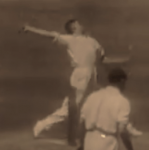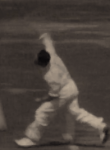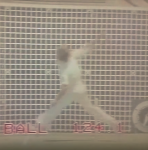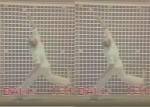Just gotta address a couple of these:
Wrong-foot bowling
Mike Procter’s bowling action was odd but it wasn’t that odd. The idea that he actually pivoted on his right foot while bowling high-pace right arm is just plain absurd and a physical impossibility. What he did do was bowl chest on and release the ball incredibly late in his action, so late that his right leg was as good as past his left leg when the ball left his hand. But that left foot was still firmly planted. Just have a look on YouTube.
It's actually the opposite of what the Patrick describes, in a 'wrong footed' action the opening of the hips and the swing of the arm occurs very early with respect to the delivery stride. Now side-on footage of Procter is hard to find, so I've got a front-on picture of Procter and a side-on picture of a bowler with a nearly identical action, a guy called Sandy Baxter who was a fast-medium amateur from the thirties, at left, and I've put them against a conventional contemporary of each, Graham McKenzie and Harold Larwood respectively, at right.
As you can see, the bowling arm is much closer to release at front foot contact for the 'wrong-footed' bowlers than for the conventional bowlers. You'll find this for other 'wrong-footed' bowlers such as Lala Amarnath and Sohail Tanvir as well. The front foot only contacts the ground just before delivery.
Pace Before 1914
The tales of pre-1914 pace bowlers are legion. Ernie Jones parting the doctor’s beard, Albert Kortright sending bails to the boundary or Tibby Cotter smashing stump after stump. But by and large they are tales and the overwhelming evidence points to genuine fast bowling being largely an undiscovered art until Gregory, McDonald and Larwood in the inter-war years. With no speed guns or reliable film footage how do we judge? Contemporary reports can be misleading but contemporary comparisons can also be revealing. South African JJ Kotze is usually bracketed with the quicks of the Edwardian age – but his ’keeper Ernest Halliwell was in the habit of standing up to the stumps. Look at pictures of Tom Richardson or Kortright in action and the wicketkeepers are barely five yards behind the stumps although the slips are plenty further back. George Hirst and Monty Noble both had their ‘keepers up. Tiger Smith often stood up to opening ‘quick’ Frank Foster. Go back a decade and Charlie Turner is described as ‘medium paced’ or even ‘medium fast’; he was in fact a spinner and was accurately measured at 55mph. Maybe Jones and Cotter were quick. Maybe. Jones took 32 wickets in four Tests at 17 each which smacks of something special. Unfortunately this was sandwiched in the middle of 15 other Tests where he managed just 32 more wickets. Cotter lasted longer but nothing points to him being outrageously fast compared to English contemporaries such as Fielder or Brearley. The very fastest bowlers were averaging less than 80mph.
I think this one's quite wrong. When Gregory and McDonald came along they were acknowledged as being very fast, but no-one said that they were the fastest ever. Your reliance on the keeper rather than the slips is strange considering that keepers can vary their position and keeping up to bowlers around the 130 km/h mark is not unknown these days even when keepers go back as a matter of course to almost anyone bowling seam up. In the golden age you are coming out of an era around 1880 or so when fast bowling had undergone a widely attested decline due to the advance in batsmanship making simply bowling fast without great accuracy, let alone movement, unviable. Hence keeping attitudes were very much 'all up to the stumps' even for bowlers faster than you might consider sensible. Keepers moved back - Dick Lilley was one of the first - when it became clear it was the better strategy. Whereas slips fielding has much less attested change. Since the ball obviously has to carry for the slips fielder to come in to play, they are a good indicator of pace. The forward position of keepers didn't disappear quickly, it's common inter-war to see them halfway, and you see it occasionally post war. Field distance is also poor to judge, say, Cotter, who was only 173 cm and bowled with a very low action, he simply wouldn't get the carry.
There were other changes too - bowling moved from mainly finger spun to seam up gradually up to the mid fifties, cutters are slower but they don't have to be loopy slower balls like in a modern T20, I've seen Broad and Gough bowl cutters at only around 5-8 km/h below their usual pace, Lillee and Trueman are known to have done the same. The stock delivery would have been slower by necessity for most fast bowlers, but the fastest not.
I do think there were certainly bowlers sometimes called 'fast' who were very much military medium by modern standards - Stanley Jackson is called 'fast' by some authors but Digby Jephson puts him as either fast or medium - 'fast-medium', which doesn't adopt its modern meaning (with variation) until about the mid-fifties. I do have my own theories on how the terminology has evolved, but that's neither here nor there.
Hirst and Foster are poor examples as they were considered just above medium type 'fast-medium' in their day, and Noble even worse, he was on the slower side of medium as far as I know. With Turner, he was considered slightly above medium at fastest by most and only Turner himself really seems to have thought he was 'fast-medium'. He was, as far as I know, measured at 89 km/h with a Boulenge chronograph, where the projectile has to penetrate two mesh screens and trip a circuit. Great for bullets and artillery, but - bearing in mind I'm no expert on chronographs - I don't think a poorly shaped object of low density like a cricket ball would be measured very accurately, with a big error slower due to loss of momentum on penetrating the first screen.
It's all and well dismissing opinions as 'in my day' nostalgia or 'tales' (and there is often
some validity to this), but if, as you assert Patrick, modern fast bowling was very much a post-Great War phenomenon, well there are many witnesses who spanned the war, some such as Hobbs, Woolley and Rhodes even played with success. If it was a new thing, why didn't they notice?

























